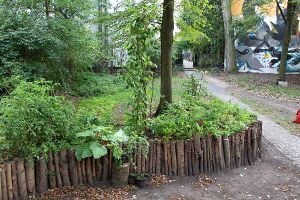
The use of a permanent raised beds is a great way to reduce work when you start your season. It reduces erosion and allows better drainage, and enables people to participate in gardening who are not physically able to work a ground-level bed. It's usually used in combination with mulch. The raised bed can have a framework or not, depending on the needs.
- Without a frame, it's more likely to erode unless plants are installed on the side of the bed with mulch. This allows more cultivation space and more productivity.
- Framed beds are more stable but will entail substantial amount of labour and much expense, depending on the type of material chosen for construction. The frames often harbour perennial weeds and plant pests which are hard to remove
- Keyhole gardens are a circular version of a framed raised bed. The charity 'Send a Cow' is promoting the creation of these in Africa.
See also[edit | edit source]
External links[edit | edit source]
- Wikipedia:Raised bed gardening
- Raised-Bed Gardening - University of Missouri Extension.
- Keyhole Garden - Send a Cow
- Video showing how to make a Keyhole Garden - Youtube content